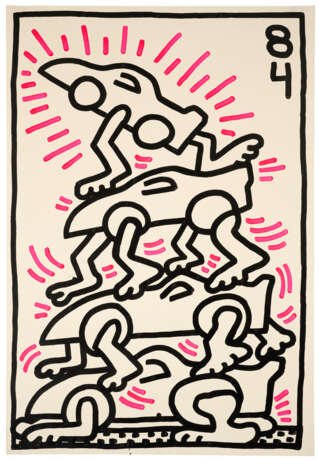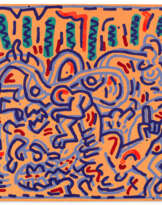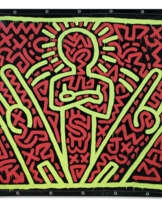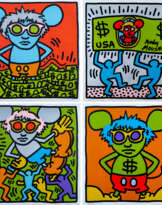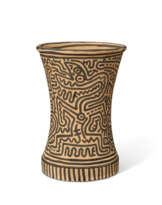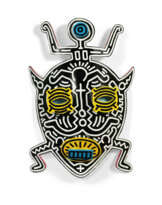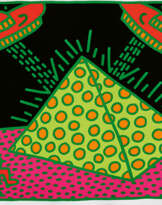ID 813929
Lot 31 | Keith Haring (1958-1990)
Estimate value
€ 150 000 – 200 000
Untitled (Le Mans)
daté '84' (en haut à droite); signé et daté 'K. Haring June 16 - 1984 +' (au dos)
acrylique et encre sumi sur papier
110 x 75 cm.
Réalisé en 1984.
dated '84' (upper right); signed and dated 'K. Haring June 16 - 1984 +' (on the reverse)
acrylic and sumi ink on paper
43 1/4 x 29 1/2 in.
Executed in 1984.
Provenance
Collection privée, Le Mans
Galerie Jérôme de Noirmont, Paris
Acquis auprès de celle-ci en 2004
Literature
W. Becker, A. Kolossa, G. Mercurio, J. de Noirmont, E. Pdrini, Keith Haring, Milan, 2000 (illustré en couleurs p. 57).
W. Becker, J. Gruen, G. Mercurio, M. Panepinto, E. Pedrini, Keith Haring, Milan, 2000 (illustré en couleurs p. 62).
Exhibited
Paris, Musée Maillol - Fondation Dina Vierny, Keith Haring, made in France, juin-septembre 1999 (illustré en couleurs au catalogue d'exposition p. 16).
Pise, Palazzo Lanfranchi, Keith Haring, décembre 1999-mars 2000 (illustré en couleurs au catalogue d'exposition p. 67).
Helsinki, The Amos Anderson Art Museum, Keith Haring, avril-août 2000 (illustré en couleurs au catalogue d'exposition p. 62).
Aix-la-Chapelle, Ludwig Forum fur Internationale Kunst, Keith Haring, septembre-novembre 2000 (illustré au catalogue d'exposition).
Rome, Chiostro del Bramante, Keith Haring, décembre 2000-février 2001 (illustré en couleurs au catalogue d'exposition p. 62).
Special notice
This item will be transferred to an offsite warehouse after the sale. Please refer to department for information about storage charges and collection
details.
Post lot text
« Je crois que Keith Haring est un prophète, dans sa vie, dans sa personne et de son travail. […] certainement par son art, ses écrits et son enseignement, Keith influencera d’autres peintres – et probablement de façon très profonde […]. De même que personne ne peut regarder un tournesol sans penser à Van Gogh, personne ne peut entrer dans la métro de New York sans penser à Keith Haring. C’est comme ça ». - William Burroughs
“I think Keith is a prophet in his life, his person, and his work […]. Certainly through his art, his writings, his teaching, Keith will influence other painters – probably profoundly […]. Just as no can look at a sunflower without thinking of Van Vogh, so no one can be in the New York subway system without thinking of Keith Haring. And that’s the truth.” - William Burroughs
« J'ai toujours eu l'impression d'être gêné par la toile, parce que la toile semblait avoir une certaine valeur avant même qu'on la touche. J'avais l'impression que je ne serais pas libre, de la manière dont je travaillais sur le papier — parce que le papier était sans prétention et totalement disponible et n'était pas si cher que ça ». - Keith Haring
‘’I always felt I would be impeded by canvas, because canvas seemed to have a certain value before you even touched it. I felt I wouldn't be free, the way I was working on paper-because paper was unpretentious and totally available and wasn't all that expensive.’’ - Keith Haring
Keith Haring commence à dessiner dans le métro new-yorkais au début des années 1980. Réalisant compulsivement jusqu’à quarante images par jour, il dessine alors à la craie sur les surfaces noires laissées par les espaces publicitaires vacants. Combinant un humour subversif issu de la contre-culture urbaine à des éléments plus sophistiqués tirés de sa vaste culture artistique (Haring se réfère souvent à Alechinsky, Dubuffet, Christo, Matisse ou les peintres de l’action painting comme sources d’influence et d’inspiration), ses œuvres se révèlent d’une grande richesse sémiologique et sont le plus souvent dotées d’une forte charge politique, en s’emparant notamment des grandes luttes de la fin du siècle dernier : combat contre le racisme, l'apartheid, l'homophobie et les discriminations en tous genres. Son œuvre s’attache en outre à être accessible au plus grand nombre : « l’art transite par Haring, comme s’il était un véhicule, qui ferait remonter à la surface les grands symboles de l’imaginaire et de l’inconscient collectif » (Gianni Mercurio, Keith Haring, Milan, 2008, p. 21).
Keith Haring accepte en 1984 l’invitation des organisateurs des 24 heures du Mans, voyant dans cette course populaire un moyen de faire toujours davantage descendre l’art de son piédestal, pour mieux le confronter à la vie. Dans ce cadre, il réalise notamment l’œuvre aujourd’hui conservée dans la collection du Comte et de la Comtesse Jean-Jacques de Flers, emblématique de sa technique caractérisée par la spontanéité et l’assurance de son geste : les œuvres sont réalisées la plupart du temps en un seul jet, les formes venant s’imbriquer naturellement les unes dans les autres : « Ce que je préfère dans le travail de Haring, c’est que, quand il a fini une pièce, il n’y a jamais rien que l’on puisse vouloir changer. Même quand il réalise une œuvre en une seule fois, il n’y a pas un seul faux mouvement. Tout est si bien dessiné – et montre une telle cohérence entre les éléments. C’est tellement beau ! ll a vraiment fait des choses fantastiques » ! (Roy Lichtenstein cité in G. Mercurio, op. cit., p. 129).
Keith Haring began drawing in the New York subway during the early 1980s. Compulsively producing up to forty images a day, he sketched with chalk on the black surfaces left by vacant advertising spaces. Combining subversive humour derived from urban counterculture with more sophisticated elements drawn from his vast artistic culture (Haring often refers to Alechinsky, Dubuffet, Christo, Matisse or the painters of action painting as sources of influence and inspiration), his works reveal a great semiological richness and are more often than not endowed with a strong political charge, notably by seizing upon the great struggles that took place at the end of the last century: His work focuses on the struggle against racism, apartheid, homophobia and discrimination of all kinds. It also also strives to be accessible to as many people as possible: “Art passes through Haring, as if he were a vehicle that would bring to the surface the great symbols of the imagination and the collective unconscious.” (Gianni Mercurio, Keith Haring, Milan, 2008, p. 21).
In 1984, Keith Haring accepted an invitation from the organisers of the famous 24 Heures du Mans, seeing this popular car race as a way of bringing art down from its pedestal, the better to confront it with life. In this context, he produced the work now in the collection of the Count and Countess Jean-Jacques de Flers, which is emblematic of his technique characterised by the spontaneity and assurance of his gesture: the works are mostly produced in one fell swoop, with the shapes fitting naturally into one another: “What I like best about Haring’s work is that when he’s finished a piece, there’s nothing you could think of that you’d want to change. Even if he did something all at once there just isn’t a false move. It’s all so beautifully drawn – and there’s such a sense of relatedness. The stuff is beautiful! He’s really done some gorgeous things!” (Roy Lichtenstein quoted in G. Mercurio, op. cit., p. 129).
| Artist: | Keith Haring (1958 - 1990) |
|---|---|
| Art style: | Contemporary art |
| Auction house category: | Paintings |
| Artist: | Keith Haring (1958 - 1990) |
|---|---|
| Art style: | Contemporary art |
| Auction house category: | Paintings |
| Address of auction |
CHRISTIE'S 9 Avenue Matignon 75008 Paris France | ||||||||||||||
|---|---|---|---|---|---|---|---|---|---|---|---|---|---|---|---|
| Preview |
| ||||||||||||||
| Phone | +33 (0)1 40 76 85 85 | ||||||||||||||
| Fax | +33 (0)1 40 76 85 86 | ||||||||||||||
| Conditions of purchase | Conditions of purchase | ||||||||||||||
| Shipping |
Postal service Courier service pickup by yourself | ||||||||||||||
| Payment methods |
Wire Transfer | ||||||||||||||
| Business hours | Business hours
|
